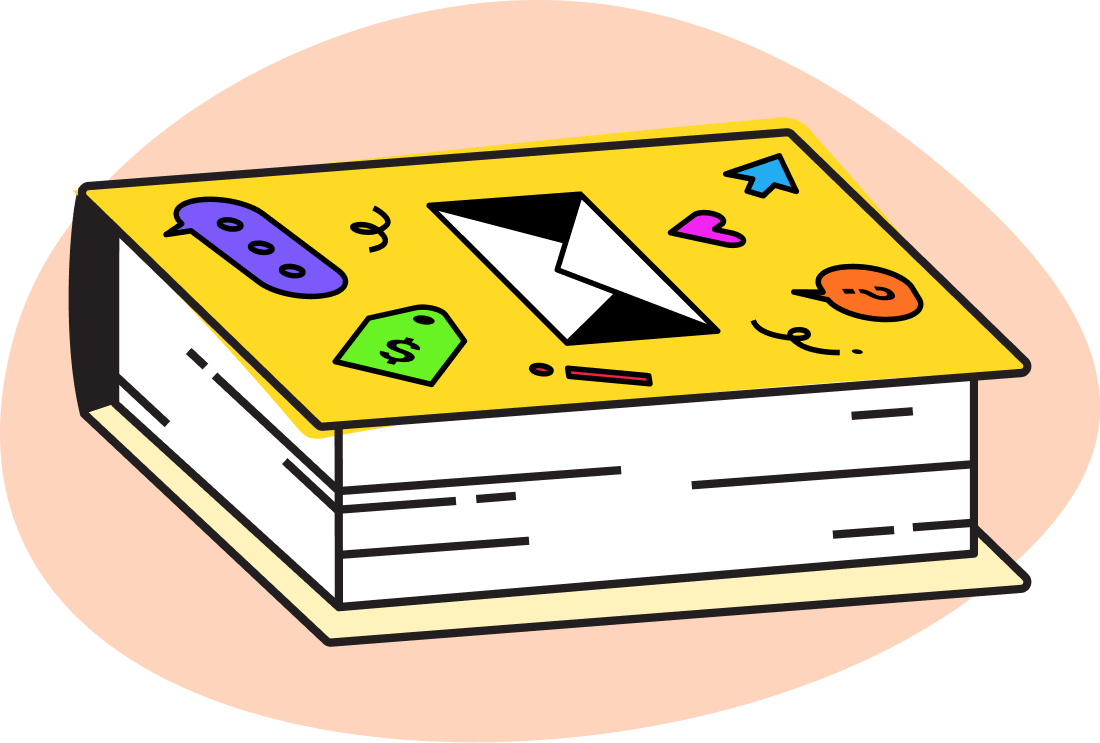Email marketing is selling through email. But email marketing doesn’t just help you make sales. It also helps surprise and delight your customers. Whether you’re welcoming them, telling them about upcoming promotions and product releases, or keeping them informed about their purchase, email marketing lets you create an incredibly personalized customer experience.
Email is a communications tool before it’s a marketing tool
At its core, email is a communications tool. It doesn’t matter how big your email list is, when you send an email, it goes to one inbox and is read by one person.
And as a communications tool, email lets you:
Build a relationship with your customer
When someone subscribes to your brand’s email newsletter, they give you permission to email them. They're essentially telling you:
- They want to hear from you
- They’re interested in your products
- They’re potential customers
But here’s the kicker. Just because someone’s signed up for your email list doesn’t guarantee they’ll become customers. Because people buy from people and companies they trust.
The good news is, email lets you establish that much-needed trust with your subscribers.
Take the time to build a relationship with your subscribers and earn their trust and they’ll be there for you—in good times and bad.
Establish a brand tone and voice
Not enough is said about the huge opportunity email presents when it comes to cementing a brand’s tone and voice.
When most brands talk about brand tone and voice they’re thinking of website copy, social media ads, products descriptions, etc.
But people only see that when they visit your website or see your ads. Email on the other hand lands in their inbox—a place that’s all on its own.
For your brand’s voice to stick in your subscriber’s mind, you need to expose them to your marketing again and again. Email’s the perfect way to do that.
Consistently sending emails establishes your brand tone and voice until your subscribers would know an email’s from you even if they don’t see your brand’s name.
Personalize the customer experience and provide value to customers
When it comes to email, personalizing the customer experience is all about sending the right email to the right person at the right time.
Is your subscriber a non-buyer? Send them a “first purchase only” offer.
Got a first-time buyer? Send them an email about when to expect their order, care tips, a personal check-in email about their experience.
Returning customer? Layout the red carpet with a personalized “welcome back” post-purchase email.
Keep in mind, a vast majority of your list will comprise non-buyers. So ask yourself, “What do they need to know or feel to trust us enough to buy from us?” and send emails accordingly.
The good news is, with every email you send, your subscribers’ action (or inaction) will tell you what you need to know to make email marketing decisions.
Use that data to provide value to customers and offer an email experience that matches their customer journey.
Brooklinen sends out an email with “care tips” after someone purchases. Not only do they tell customers how best to take care of their linen but also set expectations by letting them know what they need to do for the softest linen experience.”
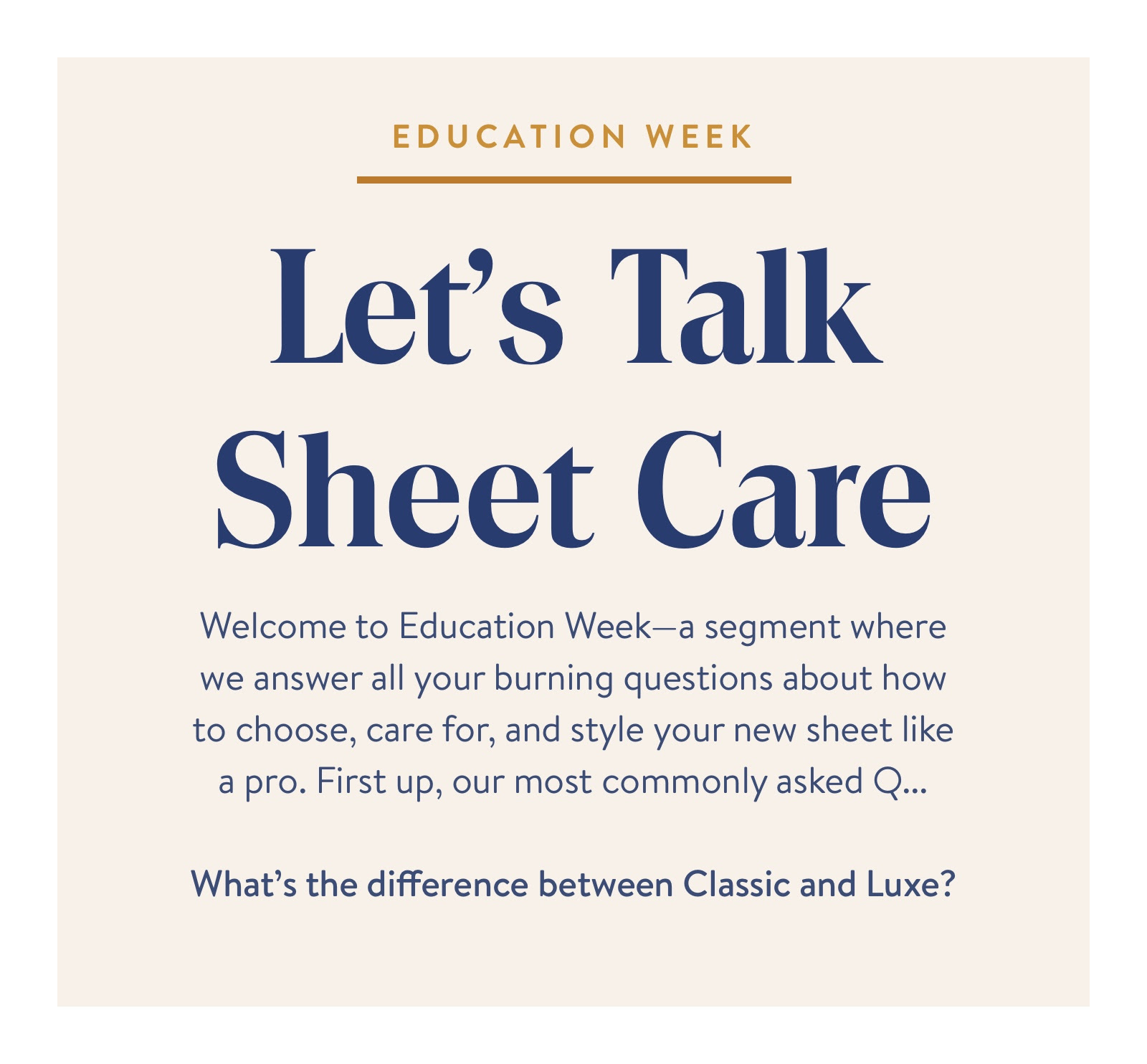
The key to emails that sell: copy and content
Let’s do a quick 10-second exercise. Think about all the brands whose emails you like to read or almost always open.
What do you like about them? What makes you open those emails?
We’re willing to bet it’s the copy.
If you’re thinking along the lines of “because they’re funny, always have helpful info, or I love their product descriptions”... what you’re really saying is that you love their copy.
You love reading those emails.
All effective emails have one thing in common: they’re being read.
Emails with good copy and content get opened, read, and clicked.
They establish trust, build brand loyalty, turn subscribers into buyers and existing customers into loyal, raving fans.
But what does good email copy look like?
Good email copy sets you apart from your competition. Take a look at this excerpt from a New Year's email by Death Wish Coffee, which is on a mission to sell the world's strongest coffee:
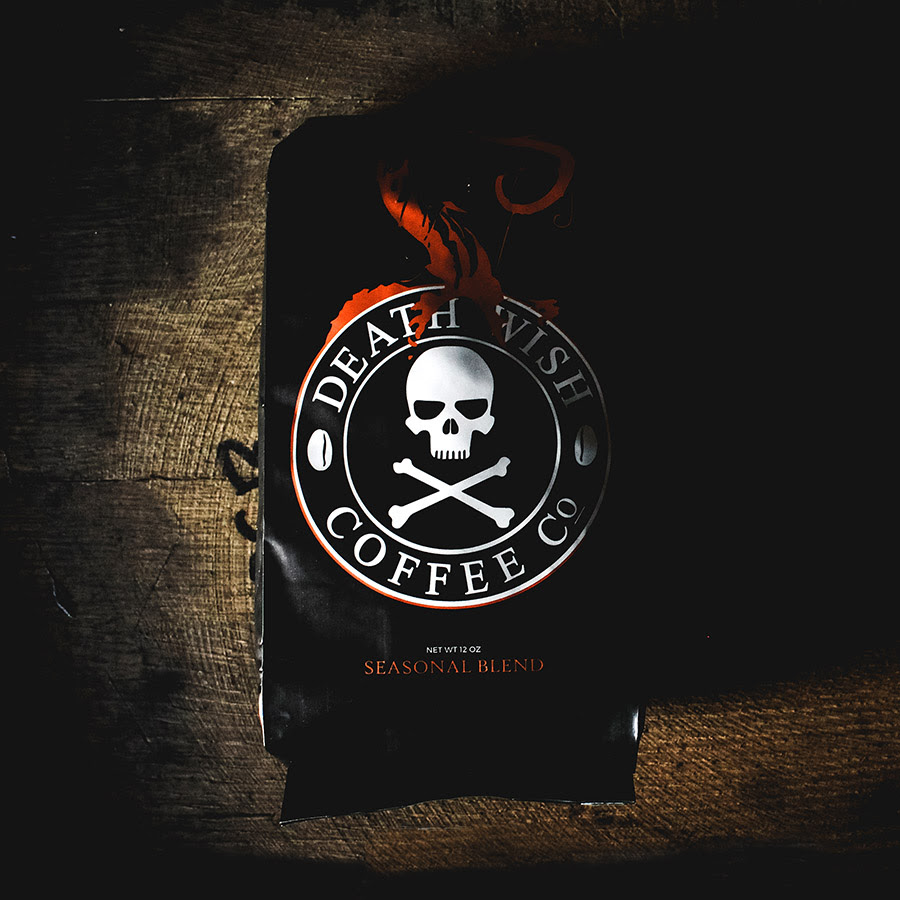
Nobody is going to mistake that for an email from Starbucks or Nespresso.
Good email copy is consistently on-brand. Your brand voice is an expression of your brand's personality. And you don't want to sound like a different person with every email—even in automated emails like post-purchase or abandoned cart or even subscription confirmation emails.Death Wish Coffee’s email newsletter subscription email keeps its coffee mission front and center. And even though the email is short, the copy makes it a fun email to read.
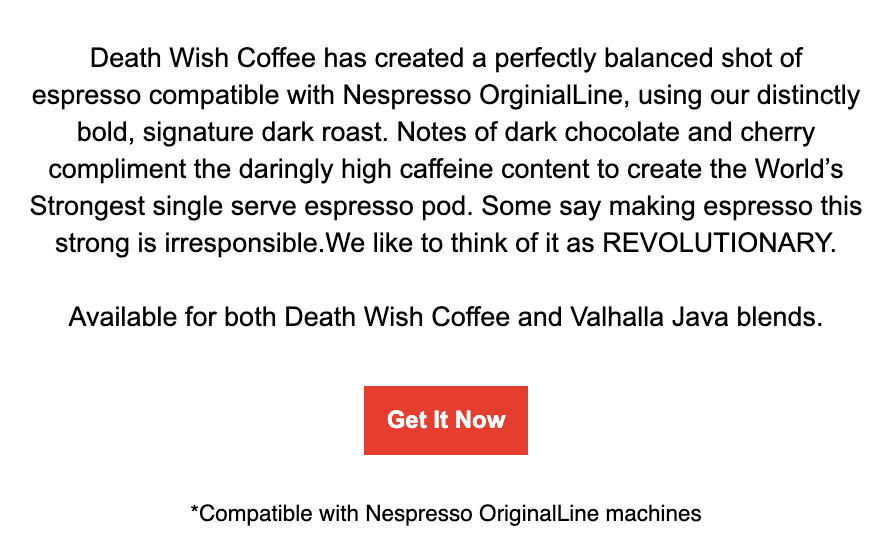
Good copy provides value to customers.Yes, the dream is to sell through email like the great toilet paper rush of 2020 but that’s a once-in-a-pandemic kind of a situation. And realistically, if you made sales at that rate, you’d have major inventory issues (as so many toilet paper companies realized to their dismay 🤷🏽♀️)But if you provide value to your customers, they will reward you with their business and you can make a substantial percentage of your total revenue from email. Now if all you can think of is discounts to make sales from emails, think again. Value can come in the shape of sending care tips to customers to help them make the most of their purchases.
How to write emails that sell: the art of the non-sales pitch.
When it comes to emails that make sales, there are three categories you should focus on.
- Lifecycle emails (a.k.a emails that sell on autopilot)
- Newsletters (a.k.a the one-off emails you send every week)
- Promotional campaigns (a.k.a the emails most brands imagine when they about email marketing.)
Each of these categories has different characteristics and a different set of rules to follow in terms of content and timing.
1. Lifecycle emails (a.k.a the emails that sell on autopilot)
Lifecycle emails are automated, behavior-triggered emails that correspond with your customer or subscriber’s journey. These triggers can be:
- Signing up for a newsletter (triggers the welcome sequence)
- Purchasing a product (triggers the post-purchase sequence)
- Adding items to a cart and then leaving without buying (triggers the cart abandonment sequence)
The absence of a certain behavior can also trigger a lifecycle email. For instance, if a newsletter subscriber hasn’t opened your emails or bought something from you in a while, you can set up a win-back sequence to be triggered to get them to come back.
What type of content can you use in life cycle emails?
The content you include in your emails depends on your goal for the sequence and the specific email within the sequence.
Feel free to send more “copy- or content-heavy” emails in your welcome sequence when you need to introduce your brand, share customer success stories, and the story or motivation behind your brand.
On the other hand, order confirmation emails are typically short, factual, and to the point.
Since lifecycle emails are trigger-based, you send them when a website visitor, subscriber, or customer behaves in a certain way.
While there are no hard and fast rules on how long you need to wait…
- Welcome emails are sent immediately after someone subscribes to your newsletter
- Cart abandonment emails can be sent anywhere between 1-6 hours after someone abandons their cart
- Post-purchase emails need to be triggered immediately too (because imagine waiting 2 hours to find out whether your order went through or not!)
- Winback emails typically depend on how you identify unengaged subscribers. That’s a decision you’ll need to take. It’s usually anywhere between 3-12 months of a subscriber not engaging with your emails.
- Replenishment emails get triggered depending on the duration of the subscription.
Once you’ve set up your lifecycle emails, go over the stats and see if you should change or update the timing of the emails. If you’re sending out abandoned cart emails four hours after someone abandons a cart, try triggering the email after two hours.You won’t know which trigger performs best until you have data to compare.
2. Newsletters (a.k.a the one-off emails you send every week)
These are the emails you send out every week or every few days to your email subscribers. They’re one-off, aren’t part of a sequence, and aren’t triggered by any subscriber action or inaction.
They’re perfect for staying on top of the mind of your customers, building brand awareness, cementing your brand tone and voice, and… making sales.
What type of content can you use in newsletters?
Think in terms of content that informs and educates as well as entertains. Below are a few content ideas your brand can use to make sales while providing value to your subscribers.
- Talk about the pain points your product solves
- Highlight the benefits of using your products
- Share customer success stories
- Send product “How-to” emails
- Highlight products including backstory, ingredients, who the product is for, and why they should try it is fair game
As for when to send them, a minimum of once a week is ideal—typically on the same day every week so your subscribers will know when they’ll hear from you.
3. Campaigns
These are your typical promotional emails. They’re hyper-focused on sales, often using urgency, discounts and limited-time offers. These emails are usually image-heavy and copy-light. In fact, the content that goes into promotional campaign emails depends on the promotion you’re running.
Ideally, you shouldn’t be running promotions all the time. Save these for special occasions like:
- The holiday season (Halloween, Thanksgiving, Christmas, New Year)
- Special events (Black Friday, Cyber Monday)
- National holidays, seasons, and themes (4th of July, Labor Day, back to school, Dry January, Valentines, etc.)
Pull up a calendar and decide which months you want to run promotions. Then decide the campaign’s duration. Promotional campaigns typically run anywhere from 3-7 days.
Whatever you do, don’t run promotional campaigns every month. And please don’t let them be the only emails you send your subscribers.
You don’t want to be known as the brand that’s always running a sale.
Our recommendation is to start sending these emails a few days before the holiday or event. For example, don’t send a Black Friday campaign on Black Friday. Instead, start a few days early and finish strong.
Writing emails that speak to your customers (but sell for you)
When it comes to writing emails the one thing you should focus on isn’t copy (Shocker, we know) but the customer journey.
Sending the right email to the right person at the right time is the key to email sales and conversions. Even emails with award-winning copy won’t convert if they’re sent to the wrong person.
The good news is, Drip makes it incredibly easy to send targeted, personalized emails by segmenting your subscribers.
Think beyond using your customer's first name. You can create different versions of the same email to target different audiences using past purchases and interactions to personalize certain parts of your email content.
When writing ecommerce emails, keep these golden rules in mind:
- One reader
- One message
- One (type of) call to action (CTA)
The 7 components of an effective ecommerce email
Despite so many different types of emails being sent out by a brand, there are a few standard components that are common in every email.
Subject lines
Since your subject lines (plus the preview text) are what your subscribers see in their inbox, they are what get your emails opened. So make them count (and A/B test different variants).
A few general rule of thumb:
- Use 40-60 characters (shorter is better)
- Clear is always better than cute
- Use emojis to emote (and sometimes decorate)
Preview text
Your preview text adds more info to your subject line. Together they tell a short story that drives your subscriber to open your email.
A few general rule of thumb:
- Should not be the same as the subject line
- 80-100 characters
- Always punctuate
Header
The header is the first thing your subscribers see once they've opened your email. Its job? To entice your subscribers to keep reading!
A few general rule of thumb:
- Add personality (with clarity)
- 50-55 characters is a safe bet
- Think of it as the opening line of your email
Subheads
Your subheads add supporting info to your header and throughout your copy.
General rule of thumb:
- Highlight important details
- Perfect spot to add personality and brand voice
- 55-60 character limit
Body copy
The most important rule for writing your email body copy?
KISS! (Keep it simple, stupid!)
Remember the golden rule of email copywriting: One reader, one message, one (type of) CTA per email.
Asking your subscribers to do multiple things in one email dilutes the conversion rate. So many ecommerce brands want their subscribers to shop, follow them on social media, and/or spread the word.
Decision fatigue is real. Also, all of those actions serve the brand and not the subscriber. Ask yourself, “What’s in it for them? Why should they do what you want them to do?”
Similarly, ecommerce emails can (and should) have more than one CTA, but that CTA needs to be of the same kind.
So if you’re an apparel brand wanting subscribers to shop, it’s okay to highlight different apparel categories in one email and make the CTA “Shop Shirts,” “Shop Shoes,” and “Shop Jackets.”
And finally, your emails may be going out to tens of thousands of subscribers but only one person at a time will be reading it. So make sure your copy addresses that one person (and not an invisible large group of people).
Your email copy should be:
- Personalized
- Conversational
- On-brand
- Formatted for speed-reading
- Interactive
CTA buttons
Don't leave it up to your readers what to do—always end with a clear call to action. Think of it as actionable and the natural next step for your subscriber to take.
Feel free to ditch the typical “Shop Now” or “Buy Now” CTAs and have fun with the copy. As long as you’re including one type of CTA, your subscribers will understand.
And don’t make the mistake of including different types of CTA in one email. You’ll end up overwhelming your subscribers and overwhelmed people don’t buy.
The CTA should:
- Be actionable
- Be a natural extension of your email copy
- Move the conversation forwards
- Hint at what comes next
- Not exceed 25 characters
Footer/banner
Ever notice a special section in an email that highlights something specific in an email?
If it’s at the bottom of the email, it’s considered a footer, if it’s at the top, it’s considered a banner.
Both footers and banners highlight information you want subscribers to pay special attention to. They can promote your social media channels, link to important content, or highlight a promotion that your brand’s running.
They make the most sense in weekly newsletters but can also be used in lifecycle emails.
Writing copy for different business goals
The type of email copy you write depends on the kind of email you want to sell and the business goals you want to serve, including:
- To connect and build relationships
- To convert and drive sales
- To educate on brands and products
Let's take a look at how these goals impact the way you write your copy.
Connect and build relationships
In this welcome email example, Beardbrand is writing to build a relationship with a new subscriber.
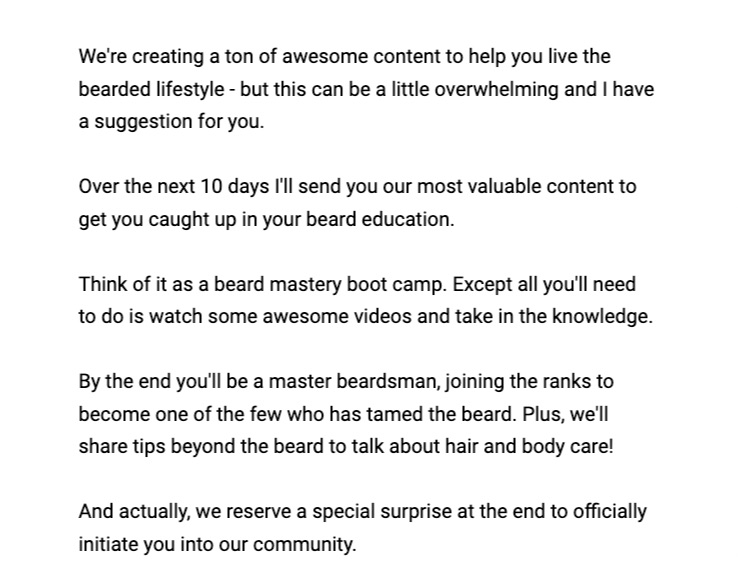
They keep it light and fun (very on-brand), explain what’s to come and build excitement. They also give their readers the opportunity to opt out of the sequence. That builds trust. With the little teaser about a special surprise at the end of the sequence, they are working at keeping them on board for the full sequence.
Notice how they offer a small fun fact at the end? This email is all about building a relationship with zero sales involved.
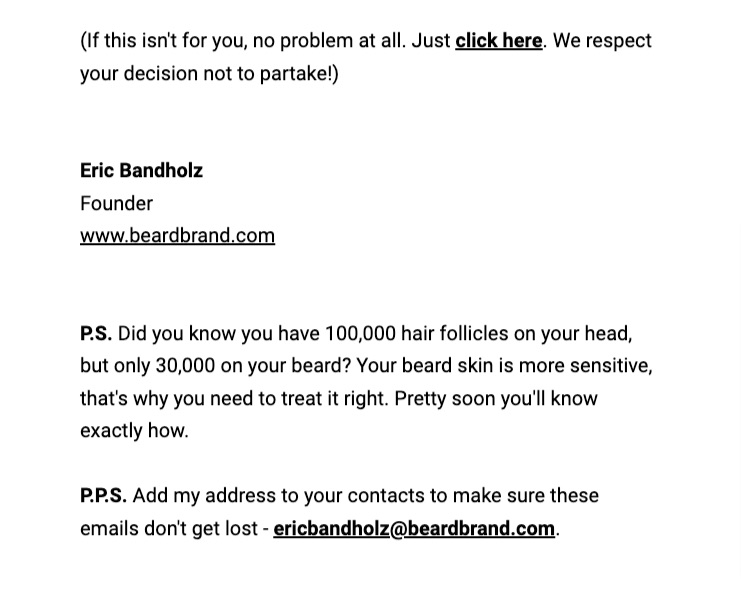
Convert and drive sales
This Labor Day Sales email by Casper show you how to drive sales:
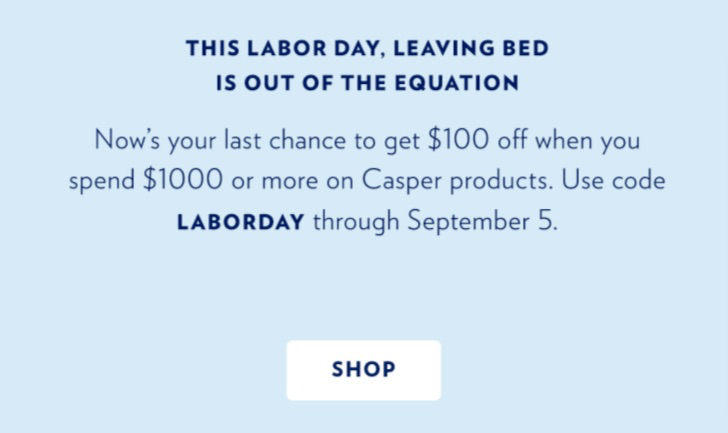
The subject line—"Last day: Save $100 with our best offer ever”—straight away goes all in, with urgency, discount, and a limited time offer.
From there, the header continues, repeats, and magnifies this urgency. It's not just the last day, these are the final hours. You’ll notice there is not a lot of fluff in this copy, it's all about the sale.
This is a hard-core promotional email.
Educate on brand and products
Creating your own card on Canva can feel tricky, so Canva explains in this email how easy it is. They start with setting the scene to draw you in: why would you want to create a design on Canva? If this intro convinces you, great, there is a CTA right there.
Not yet convinced? They continue with a quick how-to-guide. They make great use of visuals and keep the copy super short, after all, "Making a card is easy". And there's the second CTA.
An additional nudge with a discount offer. Note that the offer is linked to the subject of the email, making your own card. They don't overwhelm their readers with a smorgasbord of unrelated CTA's.
And then finally a link to a video. Check out that header. Anyone can make a card in seconds.
